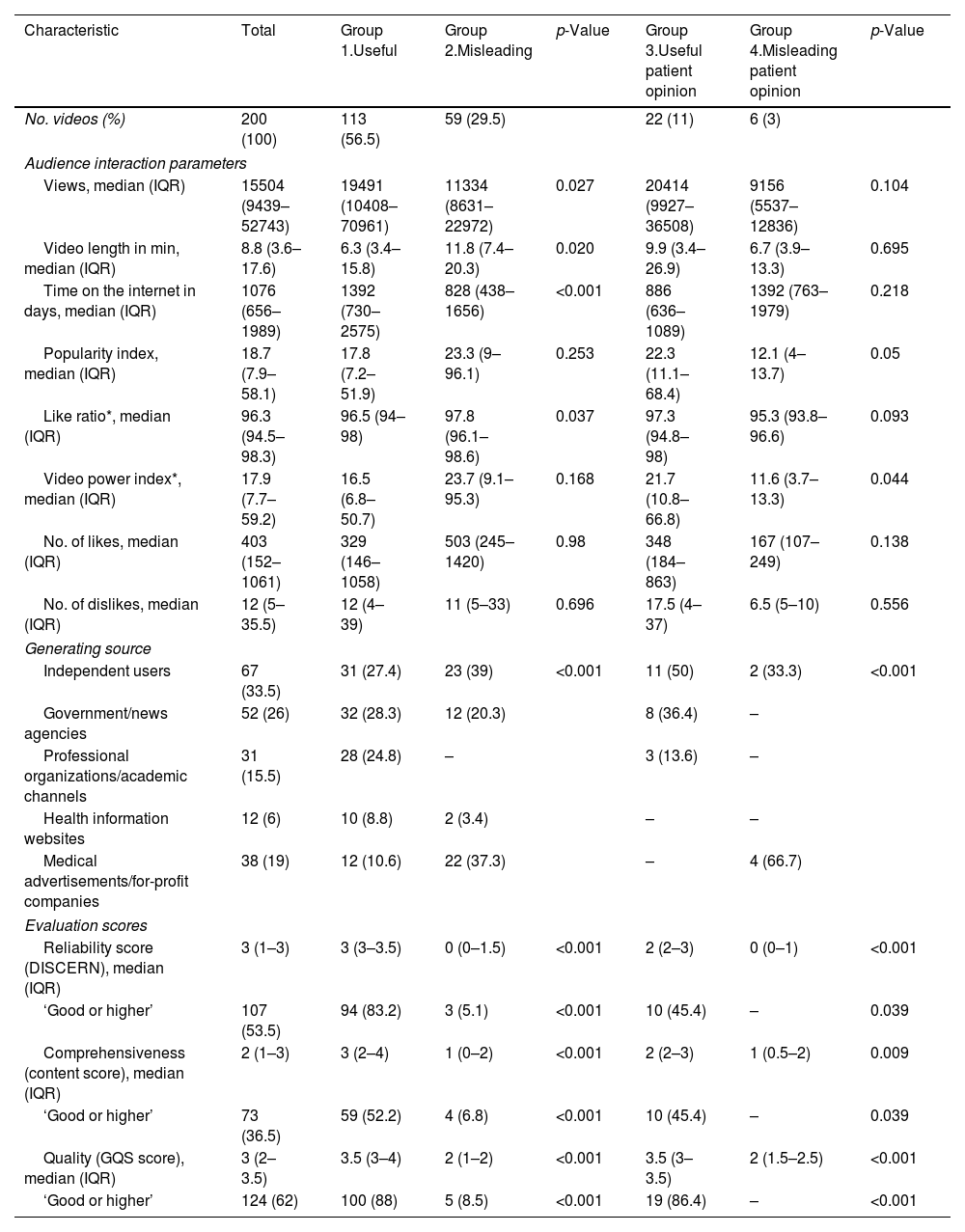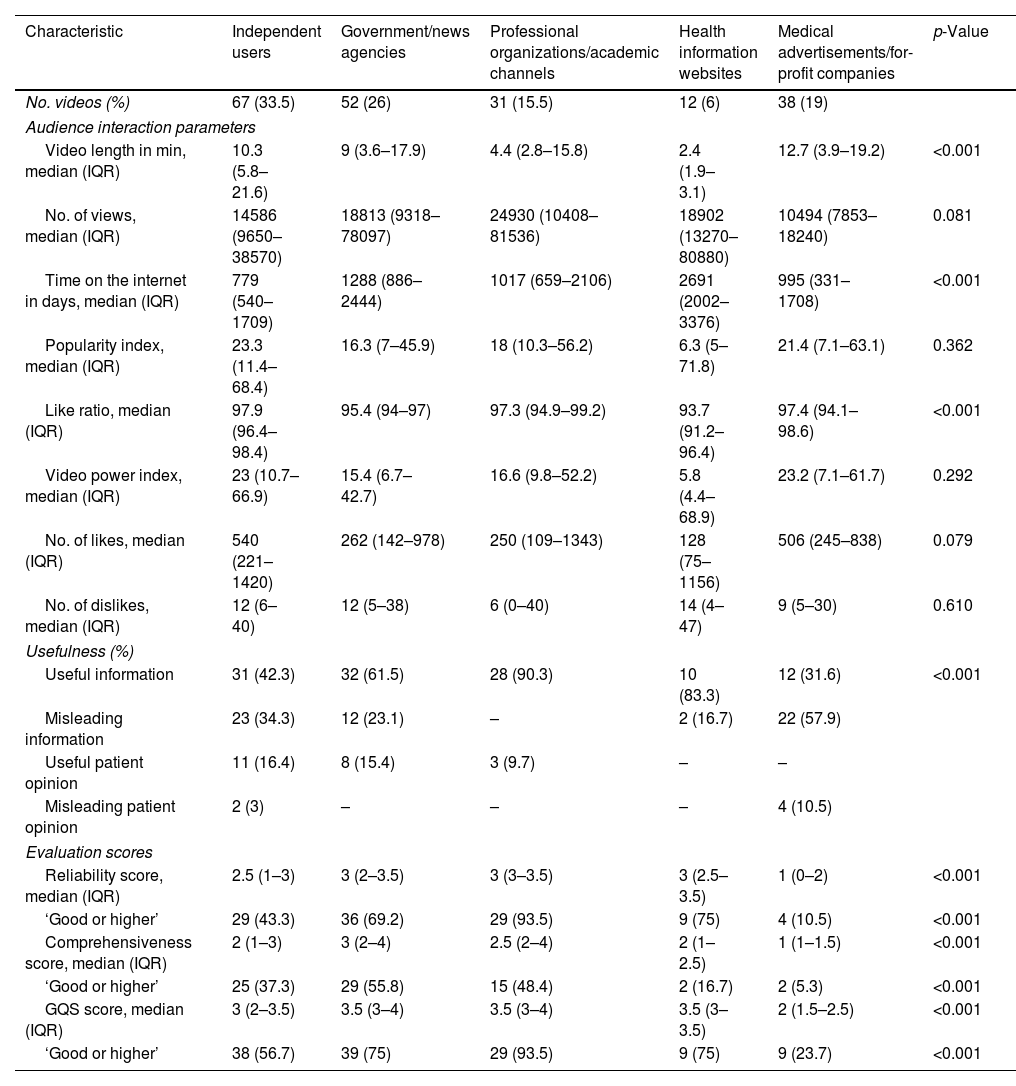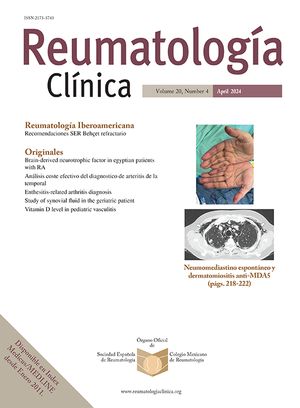Social media (SoMe) has reshaped access to health information, which may benefit patients with rheumatoid arthritis (RA), although an evaluation of the characteristics of contents for Spanish-speaking patients is lacking. We aimed to assess patient engagement, reliability, comprehensiveness, and quality of data uploaded to YouTube® for Spanish-speaking patients.
MethodsWe evaluated the videos uploaded to YouTube® in Spanish about RA. Information about video length, engagement (i.e., views, likes, popularity index), time online, and the source was retrieved; we appraised reliability (DISCERN), comprehensiveness (content score), and quality (Global Quality Score) using standardized scores.
ResultsWe included 200 videos in the study and classified 67% of the videos as useful. These videos had a higher number of views (19,491 [10,132–61,162] vs. 11,208 [8183–20,538]), a longer time online (1156 [719–2254] vs. 832 [487–1708] days), and a shorter duration (6.3 [3.4–15.8] vs. 11.8 [7.4–20.3] min). Engagement parameters were similar between useful and misleading videos. Useful videos had higher reliability, comprehensiveness, and quality scores. Useful videos were mainly uploaded by independent users and government/news agencies; academic organizations offered only 15% of useful videos.
ConclusionsMost of the information in YouTube® for Spanish-speaking patients with RA is useful; however, patient engagement is similar between useful and misleading content. More substantial involvement of academia in developing high-quality educational multimedia is warranted.
Las redes sociales (ReSo) han redefinido el acceso a la información en salud, beneficiando a los pacientes con artritis reumatoide (AR). No se cuenta con una evaluación de las características de su contenido para pacientes hispanohablantes. Nuestro objetivo fue evaluar los parámetros de interacción, la confiabilidad, la exhaustividad y la calidad de la información disponible en YouTube® para pacientes hispanohablantes con AR.
MétodosEvaluamos los videos en español sobre AR disponibles en YouTube®. Se extrajo información sobre la duración del video, los parámetros de interacción (por ejemplo, vistas, likes, índice de popularidad), el tiempo en línea y la fuente generadora. Estimamos la confiabilidad (DISCERN), la exhaustividad (puntaje de contenido) y la calidad (Global Quality Score) utilizando puntajes estandarizados.
ResultadosIncluimos 200 videos en el estudio y clasificamos a 67% como videos útiles. Estos videos tuvieron un mayor número de vistas (19.491 [10.132-61.162] vs. 11.208 [8.183-20.538]), un mayor tiempo en línea (1.156 [719-2.254] vs. 832 [487-1.708] días) y una menor duración (6,3 [3,4-15,8] vs. 11,8 [7,4-20,3] min). Los parámetros de interacción fueron similares entre los videos útiles y los no útiles. Los videos útiles presentaron puntajes mayores de confiabilidad, exhaustividad y calidad; en su mayoría fueron generados por usuarios independientes y por organizaciones gubernamentales/agencias de noticias. Las organizaciones académicas generaron únicamente 15% de los videos útiles.
ConclusionesLa mayoría de la información en YouTube® para pacientes hispanohablantes con AR es útil. Sin embargo, los parámetros de interacción son similares entre los videos útiles y los no útiles. Se requiere una mayor participación de las organizaciones académicas en el desarrollo de multimedia educativo de alta calidad.









